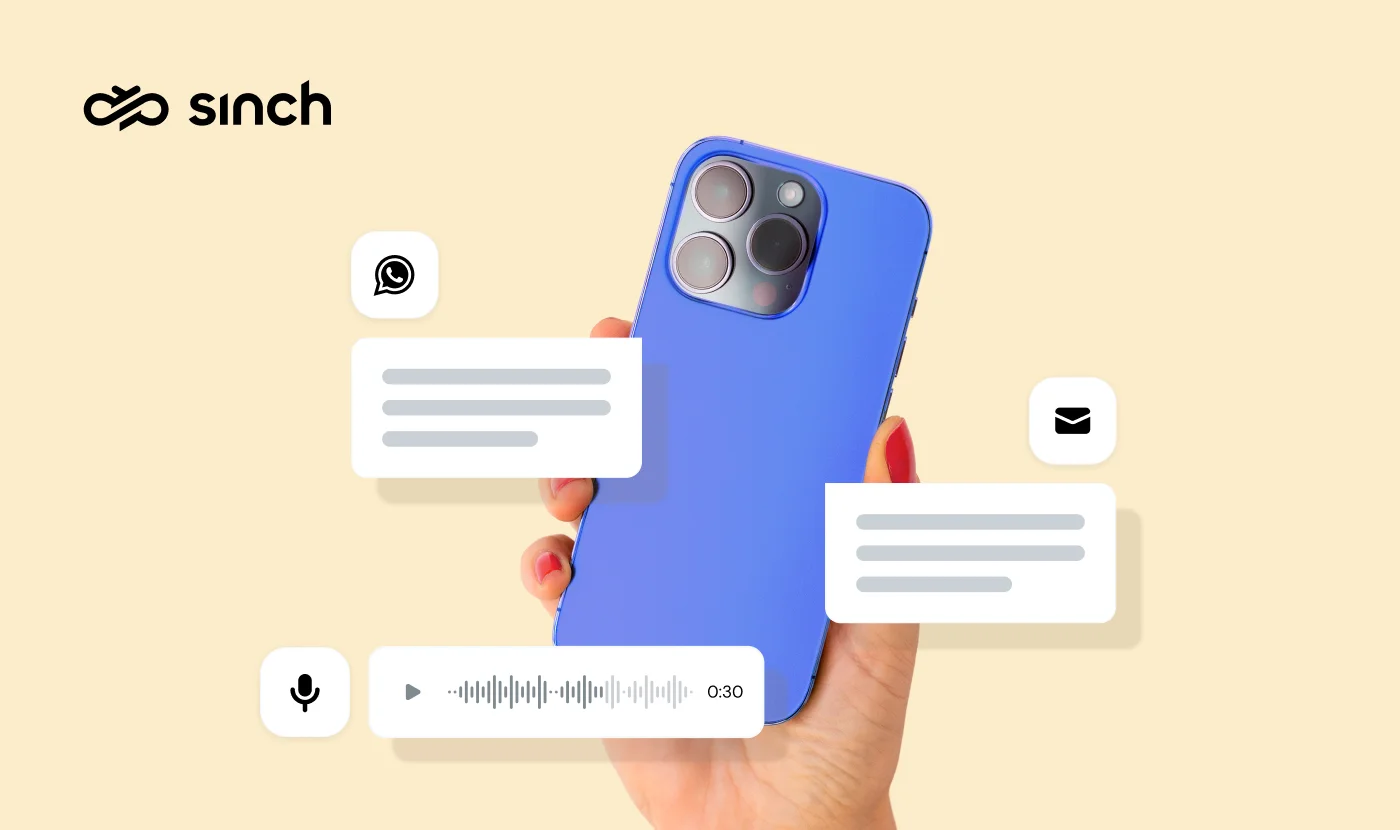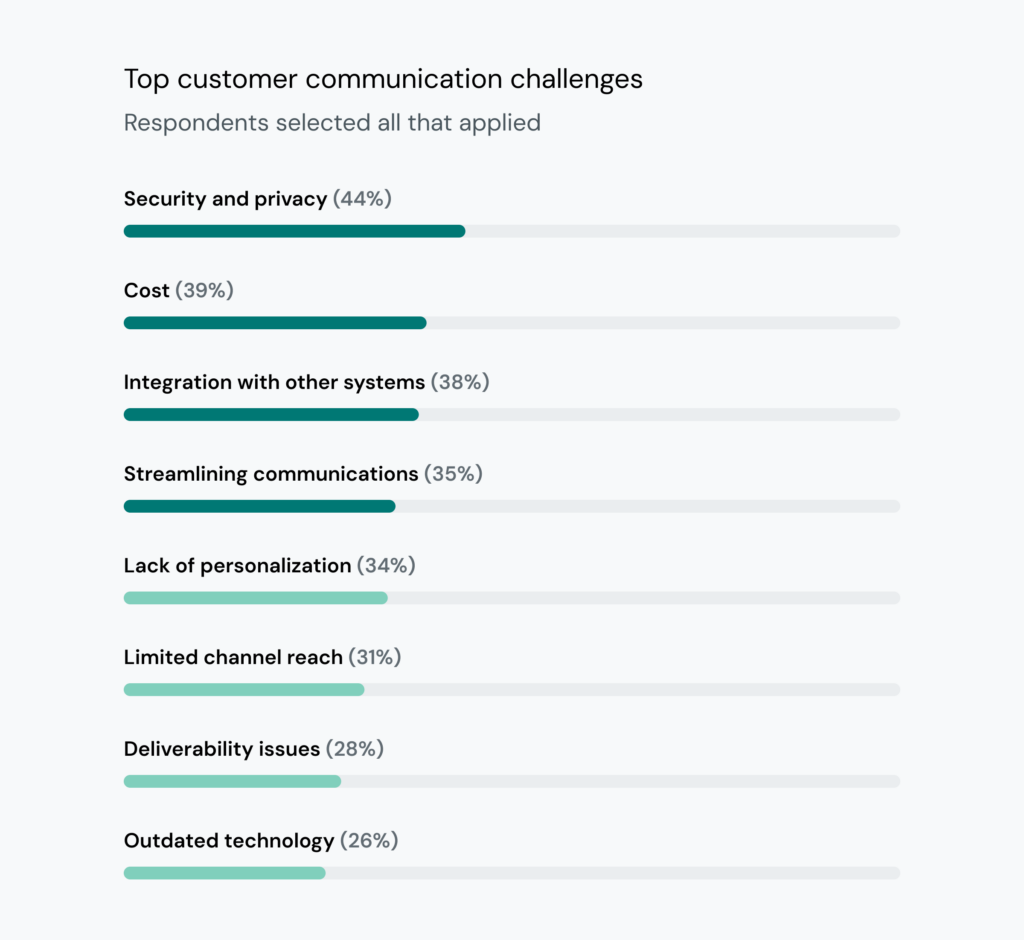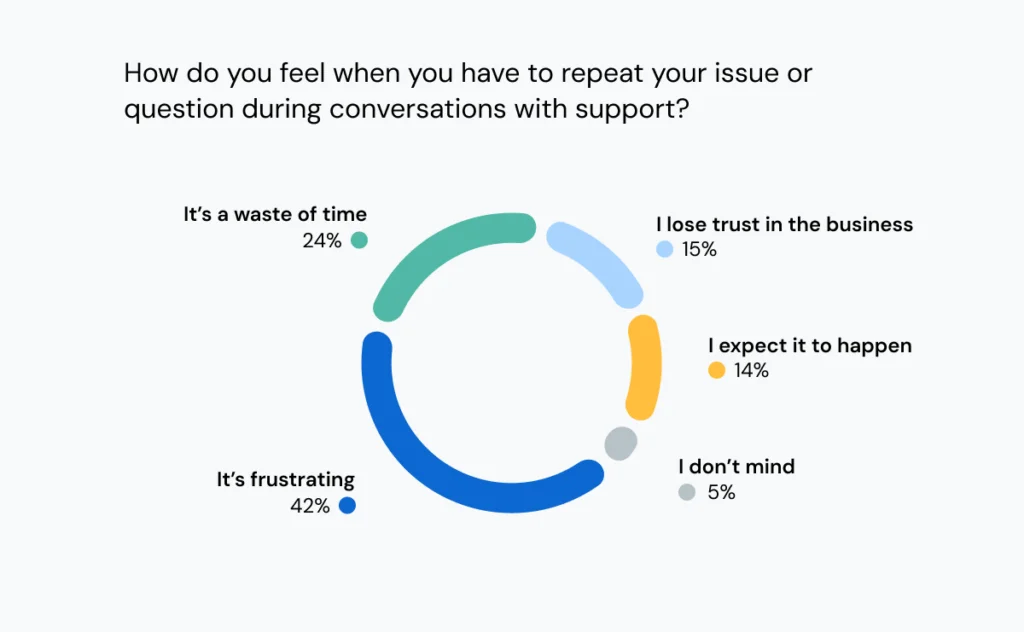Insights
Is your marketing communications mix still pulling its weight?

Insights

Marketing teams now juggle a rapidly expanding roster of communication channels – email, SMS, RCS, push, WhatsApp, chatbots, paid ads, in-app messages, and more.
But having more touchpoints doesn’t guarantee better customer relationships.
While you’ve been busy trying to maintain some semblance of a presence on nearly every channel, your customers have moved beyond simply wanting to hear from you. They want messages that inform, protect, and respect their time. The old playbook of “be everywhere” isn’t cutting it anymore.We surveyed 2,800 consumers and more than 1,600 business leaders across retail, tech, healthcare, and banking to understand the latest shifts in customer communications. The findings from The state of customer communications reveal a stark gap between what businesses think they’re delivering and what customers actually experience.
Your marketing communications mix is the set of tools, channels, and strategies you use to interact with customers, whether you’re promoting a product, sending updates, or solving a problem.
It’s the full ecosystem of channels and strategies you use to communicate across the customer journey – from traditional methods that have worked for decades to digital channels that didn’t exist even five years ago. Here are a few examples of each.
| Classic channels | Digital channels |
|---|---|
| Advertising: Paid placements like TV, radio, digital advertising, and billboards that build awareness and promote products or services to target markets. | Email: A go-to digital channel for transactional updates, promotional campaigns, and ongoing customer relationship building. |
| Public Relations (PR): Earned or owned media that shapes your positive brand image, like press releases, interviews, and media coverage that can drive word-of-mouth marketing. | SMS and MMS: Fast, direct mobile messaging that’s ideal for time-sensitive updates, price alerts, promotions, and appointment reminders. |
| Sales promotions: Limited-time offers, coupons, discounts, and short-term incentives designed to drive quick customer action and short-term sales. | Rich messaging (RCS, WhatsApp, Apple Messages for Business): Mobile-first channels that combine interactivity, media, and automation for conversational experiences. |
| Personal selling: One-on-one interactions – in person, on the phone, or via video – where a salesperson engages in face-to-face interactions aimed at closing a sale or deepening a relationship with prospective customers. | Social media: Social media platforms like LinkedIn, Facebook, and Instagram that help brands stay visible, engage target audiences, support customers, and build partnerships with influencers. |
| Direct marketing: Targeted messages sent straight to individuals via direct mail, email marketing, or SMS to encourage specific actions from potential customers. | Web and in-app experiences: Your website or app as a communication hub – from notifications and live chat to guided experiences and point of sale interactions. |
These tools form the core elements of the marketing communication mix, each serving different types of needs. Whether you’re using sponsorship deals, influencer partnerships, or product packaging as a communication vehicle, the goal is to create a cohesive marketing strategy.
Historically, these channels have been managed separately – different goals, different teams, and different tools.
But your customer doesn’t care whether your support team, marketing department, or sales team sent them a message – they just want consistent, helpful communication from your brand. Channels can’t operate in silos – they must sync in real time to feel like one brand, not ten departments.
So, the question is, “Are these channels working together to build trust, deliver relevance, and make life easier for customers?”
The old “spray and pray” approach to marketing is no longer effective. Brands may be ticking boxes across multiple channels – but customers want control over how and where they’re reached.
According to our State of customer communications research, 58% of consumers want to choose their preferred communication channel when they opt in. That’s a clear shift in expectations that many businesses still overlook, especially when weighing SMS vs email marketing for different communication needs.
And the gap goes beyond channel choice. While 55% of business leaders say their messaging is fully integrated with their tech stack, 38% still cite integration as a major challenge.

This disconnect between perception and reality often stems from treating each element of the promotion mix separately rather than as interconnected marketing communication tools that should work together to strengthen brand image.
Bridging that gap requires aligning message timing, content, and delivery with how customers actually prefer to engage. Clear, relevant communication delivered where it’s most useful builds trust and drives action.
There’s a fundamental shift in customer communication. Instead of asking “How many channels can we use?”, the focus is moving to “What outcomes do we want to achieve for our customers?”
This means designing an omnichannel marketing strategy around four core customer needs. They should feel:
When you focus on what customers actually need – instead of just checking off channels – you build trust, earn loyalty, and keep them coming back.
Today’s customers want communications that actually serve them. This means messages that are delivered at the right time, with the right information, on the channels they like to use.
These expectations have also become more specific. In 2024 we found that during peak retail periods, 80% of consumers expect personalized recommendations, and 75% want transactional messages to arrive within five minutes of a purchase.
And our 2025 research found that 36% want informational communications delivered across multiple channels, giving them options for how they receive and respond to important updates. Instead of just being nice-to-have preferences, they’re baseline expectations that determine whether customers engage with your communications or ignore them entirely.
The stakes are higher than most businesses realize. More than half of consumers say even legitimate brand messages can feel suspicious when they don’t meet expectations for timing, relevance, or channel choice. Your communications strategy directly impacts customer trust, not just engagement rates.
When businesses meet these expectations consistently, they create experiences that feel helpful and build the foundation for long-term customer relationships.
Not sure if your current communication strategy is really working? This quick checklist offers four key questions to help you self-diagnose where your marketing mix might fall short and where there’s room to improve.
Not every message belongs in an email or text. The right channel depends on how urgent the message is, and what the customer needs to do next.
Here’s what the data shows:
Different types of messages work better on different channels. Before defaulting to email or SMS, ask yourself what the customer needs to do and which channel helps them do it faster or with less effort.
We mentioned earlier how over 50% of consumers say they’ve mistaken legitimate messages from brands as suspicious.
That’s a trust gap your messaging needs to close right away. The challenge is especially noticeable in mobile marketing, where consumers often receive messages from unknown numbers or unfamiliar platforms.
Rich Communication Services (RCS) solves this with verified sender profiles that show your brand name and logo in every message, making it easier for customers to know the message is real. Similarly, businesses using WhatsApp API benefit from the platform’s verified business profiles that help customers identify legitimate communications.
Nearly 42% of consumers say these visual cues make messages feel safer. Trust is even higher among younger users.
But building trust is also about how the interaction feels.
For example, 49% feel safer when brands use one-time passwords or extra verification. But 27% see those steps as annoying. So the goal is to create a secure experience that doesn’t get in the way.
of consumers say visual cues like brand name and logos make messages feel safer.
of consumers say they feel safer when brands use OTPs or extra verification.
Personalization is more than using someone’s name in an email. In fact, 42% of consumers we surveyed said they expect promotions based on their preferences – and nearly 30% expect offers based on their purchase history.
That, for example, means:
Some of the best personalization isn’t in what you say, but when you say it.
Like a delivery update, sent before a customer asks, shows you’re paying attention. Or, an appointment reminder with prep instructions makes things easier.
When your outreach feels helpful rather than generic or intrusive, it builds trust and keeps people coming back.
of consumers expect promotions based on their preferences.
of consumers expect offers based on their purchase history.
Few things frustrate customers more than having to repeat their situation across channels. Our research shows 81% react negatively when forced to re-explain themselves to support.

This isn’t just a customer service problem. When someone gets duplicate notifications on email and SMS, or receives irrelevant promotions after a purchase, it shows your systems aren’t connected.
In fact, our research found that 59% of consumers expect their information to flow between channels and notice when it doesn’t.
Solving this requires both smart integration and thoughtful coordination. Appointment systems, campaign platforms, and support tools must sync in real time – so recent actions, like a reschedule, update the entire experience automatically.
When each interaction builds on the last, customers feel seen.
If you’re unsure whether your messages are coordinated, timely, and relevant across channels, there’s a good chance your marketing mix isn’t working as hard as it could.
The era of simply pushing messages is over. Instead of asking for more touchpoints, customers want to be understood, protected, and valued at every stage of the journey.
Brands that embrace this shift will earn loyalty. Those that don’t will keep facing disengagement, lost trust, and ignored messages.
Want to go deeper into what today’s customers really expect?
Check out the full State of customer communications report for data-backed insights. Or talk to our team about how we help enterprise brands unify their communications strategy at scale.